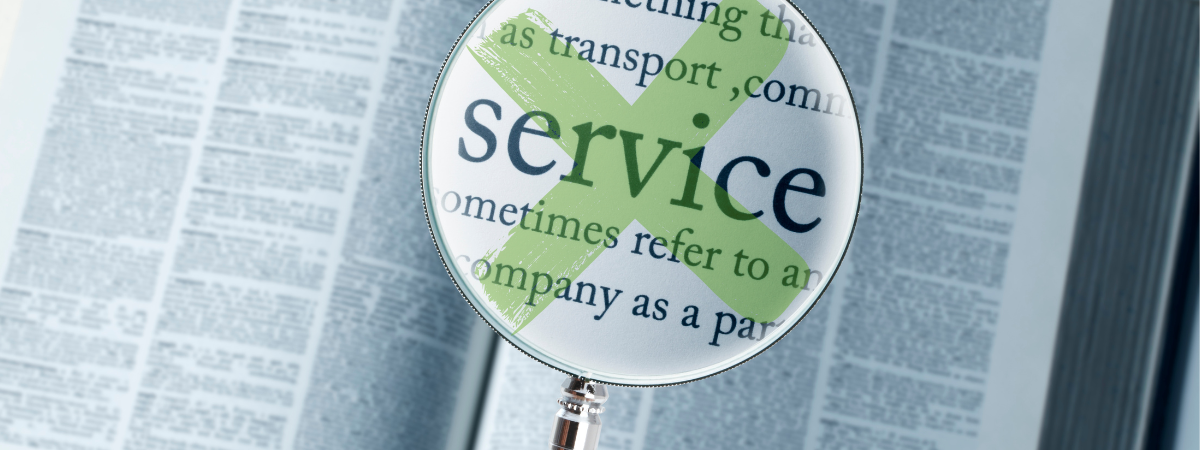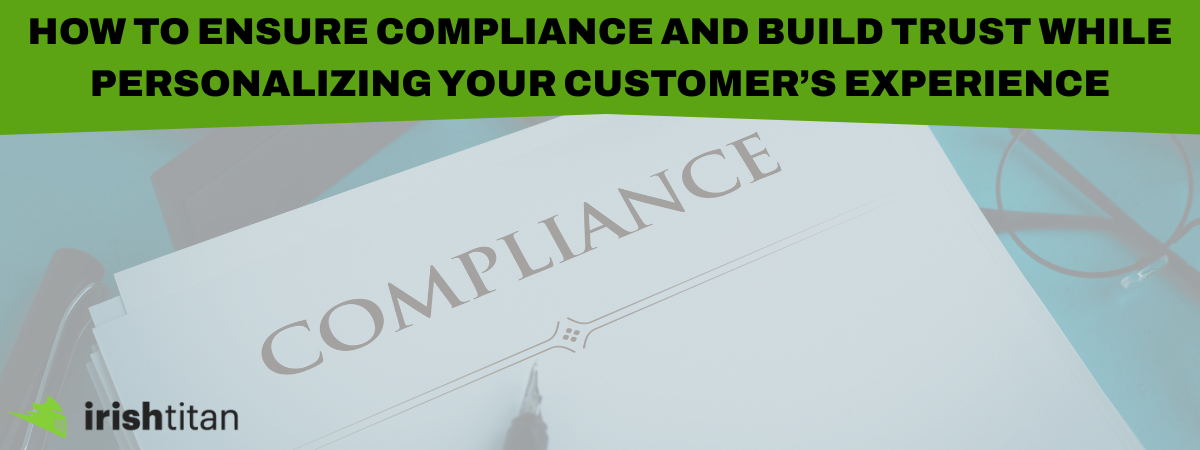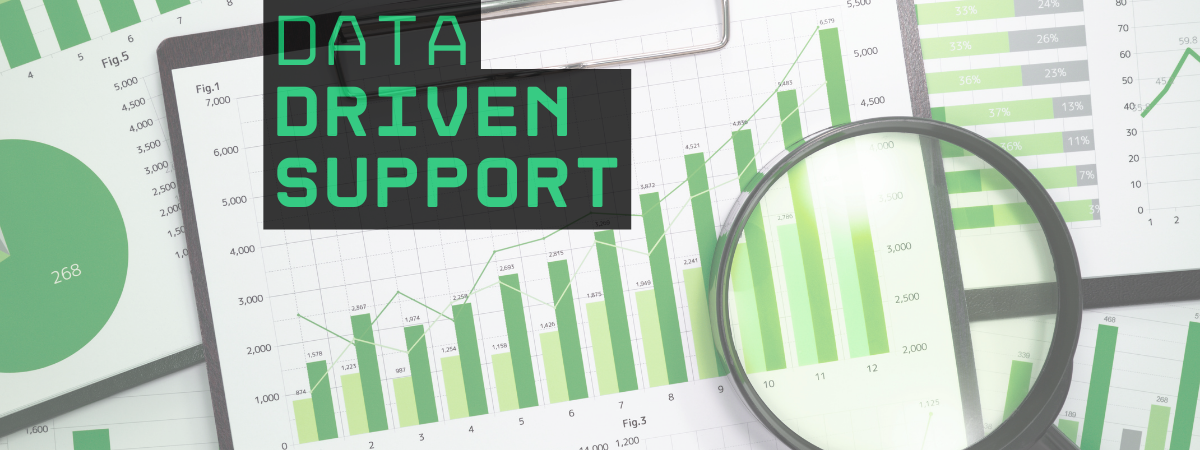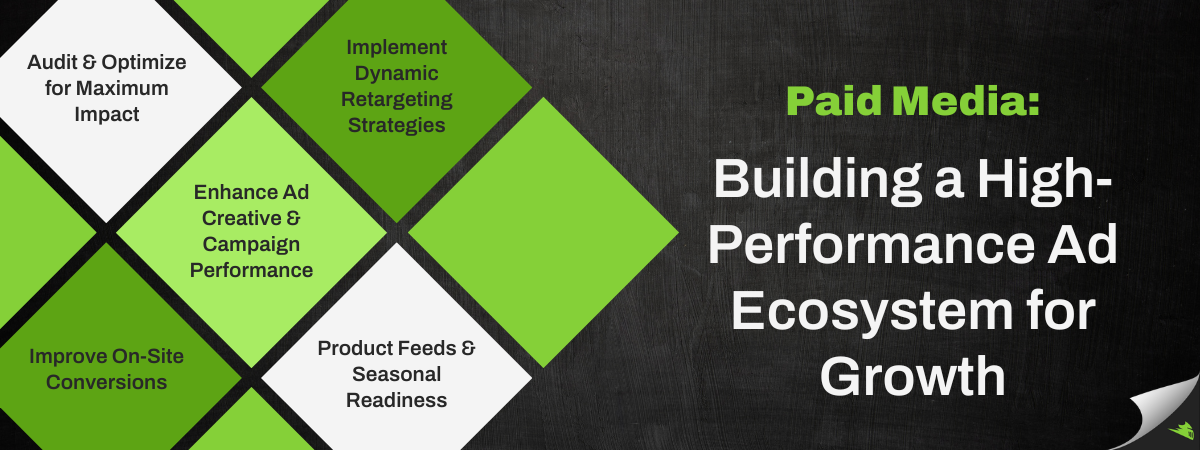Building a High-Performance Ad Ecosystem for Growth
As Q2 heats up, so does the competition. That’s why this month’s focus is all about a critical driver of ecommerce success: paid media. Running high-performing advertising campaigns isn’t just about pumping dollars into ad accounts—it’s about building a smart, scalable, and efficient digital ad ecosystem from the ground up.
From Amazon and Walmart to Google and Meta, ecommerce brands today have more opportunities than ever to reach ready-to-buy shoppers. But capitalizing on those opportunities takes more than showing up. It takes the right mix of platforms, tools, and strategies—like Channable, Feedonomics, Rebuy,and Justuno all working together.
This month, we’re highlighting how to:
- Audit and optimize underperforming campaigns
- Implement dynamic retargeting strategies
- Enhance creative and personalize messaging
- Improve on-site conversion
- Prepare for seasonal campaigns and new platforms
Because when all of these components are aligned, every ad dollar starts pulling its weight.
Optimizing Paid Media Campaigns for Maximum Impact
A well-structured paid media strategy isn’t set in stone. It evolves. Regularly auditing and refining campaign components ensures budget is allocated effectively and that the strategy adapts to shifting market trends and consumer behavior.
Audit & Adjust
Begin with the essentials: performance metrics like CTR, ROAS, CPC, conversion rate, and CAC. Use platform dashboards to assess efficiency across Amazon, Walmart, Google, and Meta. Pinpoint underperforming ads, identify gaps in targeting, and refresh outdated creative.
- Looker Studio: A powerful (and free!) data visualization tool that lets users create interactive dashboards and reports by pulling from a wide range of data sources.
- Google Analytics: A robust platform that delivers real-time insights into website traffic, user behavior, and key performance metrics—all in one customizable dashboard.
- Google Ads Dashboard: Organized into three main components—scorecards, reports, and notes—this dashboard helps you track and visualize ad performance, highlight key metrics, and document campaign insights.
Meta:
- The central command center for managing and monitoring advertising campaigns across Facebook and Instagram.
- It features a dedicated Insights section that visually showcases your ad performance in real time.
- You can also build custom dashboards tailored to the specific metrics and KPIs that matter most to your campaigns
- Campaign reporting tools provide a clear, data-driven way to measure the effectiveness of your advertising efforts. These reports make it easier to plan, optimize, and evaluate your marketing strategy with precision.There are six key types of reports available:
- Success Metrics
- New-to-Brand Metrics
- Gross and Invalid Traffic
- Reach and Frequency Metrics
- Viewability Metrics
- Off-Amazon Conversion Metrics
- Performance Dashboards put powerful omnichannel reporting at your fingertips. Leveraging Walmart’s robust first-party data, you can pinpoint the right audience, scale your reach, and gain deep insights into ad performance.
- Both Sponsored Search and Display Dashboards are available within the self-serve Walmart Connect Ad Center, giving you real-time access to campaign metrics.
- Closed-Loop Measurement powered by proprietary omnichannel intelligence, Walmart Connect links both onsite and offsite campaign performance directly to sales—across digital platforms and in physical stores—providing a complete picture of impact.
Platform Expansion
Many ecommerce brands still focus the bulk of their spend on Google and Meta. But platforms like Amazon and Walmart offer high-intent search behavior that can drive quick wins—especially with Sponsored Product campaigns and retail media networks that reach shoppers already in purchase mode.
Leveraging Amazon and Walmart Ad ecosystems
- Sponsored Product Campaigns
- Display ads
- Seasonal or Trend based Campaigns
Built Brands set out to grow their online presence on Walmart with clear goals: attract more new-to-brand customers, increase units sold, and improve ROAS. While they leveraged evergreen Sponsored Search campaigns to maintain steady visibility, a key part of their strategy was investing in seasonal experiences—specifically the “New You, New Year” campaign. This timely promotion allowed them to tap into heightened consumer interest during a critical shopping season. To maximize its impact, they repurposed top-performing keywords from Sponsored Product campaigns into manual item- and category-level campaigns, using a strategic blend of broad, phrase, and exact match targeting. Their bidding strategy was staggered to optimize efficiency across keyword types, and uncapped budgets ensured campaigns could run without interruption throughout the entire season. The results were impressive: 50% of sales came from new-to-brand customers, they achieved a 3.59 ROAS, and 40% of revenue during this period was directly attributed to their advertising efforts.
For Loftie, once they were having some success with Amazon Ads, they decided to take it a step further to make sure they could compete with bigger brands and find a way to present themselves as the better choice in the market. They launched a bunch of new campaigns specifically around the holiday time to see how they would perform. (Sponsored Products, Sponsored Brands, Sponsored display campaign).
- Amazon Video Ads
NULL, a lifestyle and wellness brand, sought to build brand awareness and drive conversions by incorporating video into their Amazon Ads strategy. Recognizing the value of high-impact storytelling, the team leveraged Amazon Streaming TV and video creative formats to connect with audiences at the top of the funnel.By pairing video ads with Sponsored Products, Sponsored Brands, and Sponsored Display, NULL created a full-funnel experience—starting with compelling video content to introduce products, followed by performance-driven formats to close the sale. Crucially, Amazon’s first-party audience insights enabled the brand to target relevant shoppers with video content that resonated. This strategic blend of awareness and performance helped NULL drive measurable impact across their campaigns.
Hasbro aimed to boost brand lift, sales, and reach for Peppa Pig and Play-Doh, identifying Prime Video as the ideal environment to connect with parents and families in a contextually relevant way. By placing ads alongside content that their audience already enjoys, Hasbro leveraged Amazon’s first-party data to target qualified households—specifically, parents with kids.
According to Hasbro’s Senior Director of Digital Media, Prime Video allowed them to reach consumers in a brand-safe, premium content environment, while also driving users from upper-funnel streaming exposure to lower-funnel sponsored brand placements on Amazon. Reached 7 million unique users over a 6-week campaign and 68% of Peppa Pig purchases during the campaign were new-to-brand, showing strong acquisition performance
- Amazon Contextual Targeting
CPG Brand aimed to increase visibility and improve ROAS by using contextual targeting through Amazon Ads. Instead of relying solely on keyword or audience-based strategies, the brand focused on serving ads alongside relevant content, such as product detail pages that aligned with their category. By tapping into contextual signals—like what shoppers were actively browsing—they were able to deliver more relevant ads at the right moment in the shopping journey. This approach allowed them to connect with high-intent audiences in a non-intrusive way, making the ads feel more like helpful suggestions than interruptions
- Sponsored Brand Videos
Loftie turned its focus to sponsored brands' videos when they found themselves trying to find a way to show that they were a better choice than their competitors. They used the videos to highlight key benefits of their products for customers. Ultimately, giving them an outlet to communicate how they stand out but also explain all the different parts of how their alarm clock works.
Implementing Dynamic Retargeting Strategies
Retargeting isn’t new—but dynamic retargeting is a game changer when done right. Instead of repeating the same static ad, brands can re-engage visitors with personalized product recommendations, upsells, bundles, or incentives.
When using dynamic retargeting, you can use real time data to dynamically generate ads tailored for each individual. It's not a “one size fits all” approach, dynamic reporting can create a custom experience for every user.
Dynamic Reporting = higher relevance + higher ROI
Behavioral Segmentation
Dynamic retargeting performs best when campaigns are segmented by intent signals:
- Product viewers
- Category browsers
- Cart abandoners
- Repeat purchasers
Most importantly though is that for dynamic retargeting to work well, your catalog must be well structured since the ad content is dynamically pulled from it. You can always utilize tools like Channable and Feedonomics to help you format and sync feeds across channels
Smart Tools
Rebuy is a tool that you can utilize in making smarter retargeting decisions using real time behavior. Think, a visitor abandons their cart and then is served an ad for the product and displays relevant add-ons.
Rebuy powers dynamic recommendations and can also help build personalized offers into the campaigns. Those may include:
Enhancing Ad Creative & Campaign Performance
The best targeting in the world can’t fix underwhelming creative. Ad assets should stop thumbs, drive interest, and speak directly to the user’s motivations.
Test & Iterate
Run A/B tests on images, headlines, calls-to-action, and formats to continuously improve performance. Analyze creative across platforms to identify top-performers and replicate their success.
Vietri was spending too much time manually managing product feeds and not enough on actual performance marketing. By implementing Feedonomics with automated product categorization and Feed AI, they were able to streamline catalog updates and eliminate manual feed maintenance. As a result of these tests and optimizations, Vietri achieved a 37% increase in ROAS, proving the value of shifting attention from feed tasks to strategic campaign management This freed up their team to focus on campaign strategy, where A/B testing played a key role in driving results:
- Tested titles and descriptions to determine which combinations improved ad delivery and performance.
- Compared Smart Shopping vs. Performance Max campaigns to evaluate which strategy delivered stronger returns.
- Used A/B testing in a low-risk environment to fine-tune segmentation, labeling, and attributes before scaling efforts.
Looking to elevate their marketing strategy and demonstrate the impact of using Feedonomics, Evo conducted A/B split testing on their streetwear products—a category unaffected by seasonality. This allowed for clean, unbiased results. By isolating variables and eliminating external trends, Evo was able to clearly show the value of feed optimization to their team. The test led to a 19% increase in ROAS, validating Feedonomics’ role in driving campaign performance.
Personalize Messaging
Use behavioral data and platform segmentation to create ads that speak directly to the individual. Highlighting features, promotions, or social proof that resonate most.
- Focus on developing copy that hits on your unique selling points (USP’s). Such as free shipping, sustainable practices or premium quality are some just examples.
Advanced Campaign strategies
-
Utilize lookalike audiences on Facebook Ads, Google Ads, Walmart or Amazon Ads to reach new potential customers similar to your existing ones.
- Rust Oleum built on the momentum of a successful new product launch through Walmart Connect by focusing on offsite display campaigns that utilized lookalike audience targeting. They identified a high-performing audience from their original campaign and used that data as the foundation for their next wave of targeting. The goal was twofold: to continue driving awareness for their new products by reaching users similar to their best-performing customers, and to test new audiences for future growth. By anchoring their targeting strategy in the proven success of that initial audience and expanding through Walmart’s lookalike modeling, Rust was able to effectively reach new users—ultimately attributing 56% of new buyers to these efforts.
-
Test automated bidding strategies, such as Target ROAS or Maximize Conversions, to optimize ad spend efficiency.
-
Launch geo-targeted campaigns to focus on high-performing regions or untapped markets.
Track What Works
Regularly monitor campaign performance and adjust based on ROAS, CVR, and CAC. Double down on creatives, products, and audience segments that consistently deliver the highest return
Improving On-Site Conversion for Paid Traffic
Driving clicks is only half the battle. Optimizing the on-site experience ensures that those clicks turn into conversions.
Align Landing Pages
Landing pages should mirror ad messaging, load quickly, and present a clear path to conversion. Mobile-first design and streamlined checkout experiences are now table stakes.
On-Site Promotions with Justuno
Deploy pop-ups, banners, and incentives tailored to paid traffic using Justuno. Exit-intent offers or limited-time deals can reduce bounce and increase conversion rates.
Federici Brands uses a multi-channel acquisition strategy—blending paid ads, social media, and influencer campaigns to drive traffic. To match this diversity in traffic sources, they needed an equally dynamic onsite experience. This layered, behavior-driven approach allowed them to personalize the visitor experience while reinforcing value at critical decision points. This strategy led to an 8% increase in average order value, simply by launching targeted pop-ups and reinforcing the gift offer before exit.
Using Justuno, they implemented:
- Channel-specific pop-ups that aligned with the ad or campaign the visitor clicked through
- A two-step gift-with-purchase exit intent strategy:
- First offer shown when an item is added to cart
- Second offer reappears if exit behavior is detected, acting as a final reminder
Hylete was looking for a resource-light solution to deliver personalized onsite experiences while gaining deeper insights into visitor behavior. To achieve this, they rolled out an omnichannel strategy that combined email opt-ins, exit offers, and intelligent product recommendations. By using traffic-source-based segmentation, they tailored welcome offers and exit popups with custom UTMs, ensuring visitors saw promotions aligned with the original ad messaging—whether they arrived via paid, organic, direct, or social channels. This consistent cross-channel messaging helped reduce CPA, boost the performance of paid traffic, and drive more efficient conversions.
The results spoke for themselves: 47% of Hylete’s email captures came from just 14% of sessions driven by paid ads, and segmented exit offers reinforced personalized experiences that extended engagement—especially for high-cost traffic sources.
Optimizing Product Feeds & Seasonal Readiness
Product data is the fuel for successful ad campaigns. Optimized feeds ensure that product listings are clear, consistent, and aligned with each platform’s algorithm.
Feed Management with Channable & Feedonomics
Audit and structure product titles, descriptions, and images for every ad platform. Use automation tools like Channable and Feedonomics to apply channel-specific rules and keep inventory synced in real time.
Volero was manually managing Amazon ads across a catalog of 5,000+ products—an inefficient and error-prone process. To improve performance, they implemented Channable’s data management and automation tools. By automating their Amazon advertising, Volero doubled their ROAS compared to their previous manual campaign setup. This switch allowed them to:
- Save significant time and reduce manual errors
- Streamline their campaign process
- Optimize data management for better ad targeting
Keepershandschoenen struggled with manual ad management—tracking performance and adjusting bids across 2,000+ products without automation made it difficult to scale effectively. To solve this, they implemented Channable’s Bol ads automation, gaining full control over which products were advertised and how. With these automation tools in place, Keepershandschoenen achieved a 55% increase in ad revenue. Key strategies included:
- Using brand rules to filter and advertise only the most relevant products
- Creating automated campaigns with if/then rules for keyword exclusions and ad structuring
- Automatically harvesting high-performing search terms and removing low performers
- Optimizing product targeting so campaigns could run efficiently with minimal manual input
Cortina wanted to spend less on branded search ads but still keep the same traffic and order volume. The goal was to cut spending by 20% and use those savings to attract new customers. Instead of just saving 20%, Cortina cut branded ad spend by 64%—without losing performance. The extra budget was then reinvested to grow their customer base more efficiently. To make it work, they needed a smarter way to manage branded campaigns—adjusting ad spend based on when they already ranked well organically. Using Channable, Cortina:
- Pulled organic search data from Google Search Console
- Filtered out non-branded terms and duplicates using automation rules
- Created dynamic ad campaigns with smart bidding based on live data from both Google Ads and Search Console
APG & Co. was running a multi-channel digital strategy to acquire and re-engage customers, but managing product feeds manually across seven platforms (Google Shopping, Facebook, Criteo, Rakuten, Klaviyo, Snapchat, Pinterest) was time-consuming and limited their ability to optimize campaigns or segment audiences.By implementing Feedonomics, they centralized feed management, gained control over product data, and unlocked segmentation by category and funnel stage. This allowed their team to shift focus from manual formatting to campaign strategy and execution. As a result, they saw a 48% drop in CPC, an 86% increase in ROI for one brand, and saved countless hours—making their marketing more agile, efficient, and performance-driven.
Seasonal Campaign Planning
Preparing for seasonal peaks like back-to-school or summer sales requires early planning. Align product availability, creative assets, promotions, and budget allocations around these high-traffic moments.
To enhance its annual back-to-school advertising strategy, Jif explored new tactics by integrating Walmart’s Connected Retargeting Solutions alongside its existing efforts. The campaign used a full-funnel approach that combined:
- Onsite placements: Walmart homepage feature and onsite display ads
- Offsite tactics: Walmart DSP and Pinterest retargeting
This layered strategy enabled Jif to re-engage shoppers who had already seen their ads, effectively closing the loop and reinforcing brand exposure. The campaign achieved a 33% higher new buyer rate compared to Jif’s 2022 back-to-school performance.
Explore New Channels
Diversifying beyond core platforms reduces risk and opens up new customer bases. TikTok, Pinterest, and CTV (Connected TV) offer fresh opportunities for brand storytelling and performance marketing alike.
Smarter Paid Media for Sustainable Growth
High-performing paid media isn’t built on guesswork—it’s the result of strategic alignment between data, tools, platforms, and creativity.
By integrating platforms like Amazon and Walmart, optimizing feeds with Channable and Feedonomics, deploying smart personalization through Rebuy, and converting traffic with Justuno, ecommerce brands can transform ad spend into sustainable growth.
This isn’t just about running ads. It’s about building an ad ecosystem that works together—intelligently, efficiently, and with long-term results in mind.
More reads





More from Ecommerce...

Code Red: Your Last-Minute Holiday E-commerce Toolkit. You're a bit late to the holiday planning party, and the Black Friday/Cyber Monday rush is right around the corner. But don't panic—the most c

When customers reach out, they’re not just asking for help — they’re handing you raw data on how your business is doing. Every ticket, DM, or email carries insight into what’s working, what’s confusing, and where you can improve. The challenge? Making sure none of that feedback slips through the cracks.

Customer support will always matter — but here’s the truth: most customers would rather not need it at all. They don’t want to wait in a chat queue or refresh their inbox for an answer. They want solutions, fast. That’s the philosophy behind “the best service is no service” — when customers can solve problems themselves, everyone wins.
